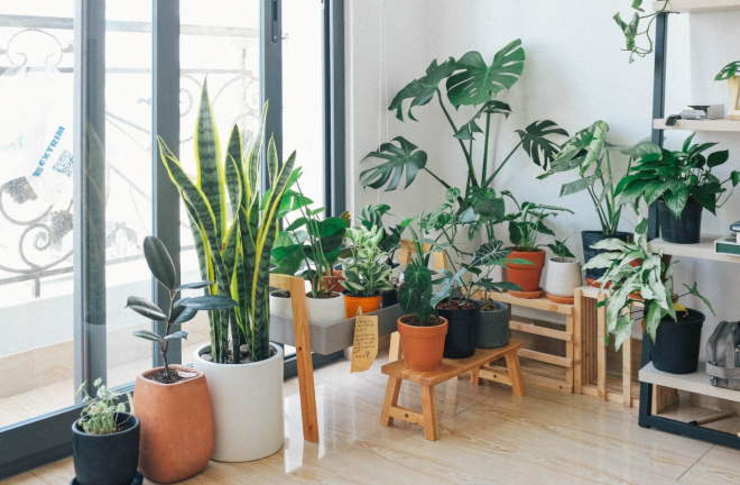How Indoor Plants Improve Air Quality
Indoor plants have increasingly become popular not only as decorative elements but also as natural air purifiers. In a world where air pollution is a growing concern, especially in urban settings, the role of indoor plants in improving air quality deserves attention. This article explores how indoor plants contribute to cleaner air, the science behind their benefits, and practical tips for incorporating them into your living and working spaces in 2025.

The Science Behind Indoor Plants and Air Quality
Indoor plants improve air quality primarily through a process called photosynthesis, where plants absorb carbon dioxide and release oxygen. However, their role in air purification goes beyond this basic function. Several studies, including the landmark NASA Clean Air Study conducted in the late 20th century, have shown that certain indoor plants can absorb harmful volatile organic compounds (VOCs) such as formaldehyde, benzene, and trichloroethylene, which are common indoor air pollutants emitted by household products, furniture, and building materials.
Plants absorb these toxins through their leaves and roots, where microorganisms in the soil further break down the harmful substances. This process not only removes pollutants from the air but also helps to increase humidity and reduce dust levels. These factors combined make indoor plants powerful allies in maintaining a healthier indoor environment.
Moreover, in 2025, recent advancements in botanical research have identified even more species of plants with exceptional air-cleaning capabilities. Researchers are also discovering how different plant combinations can create synergistic effects, making indoor air purification more efficient.
Benefits of Improved Indoor Air Quality
Improving indoor air quality through plants offers a wide range of health and lifestyle benefits:
1. Enhanced Respiratory Health
Poor indoor air quality contributes to respiratory problems such as asthma, allergies, and chronic bronchitis. By reducing airborne toxins and increasing oxygen levels, indoor plants help alleviate symptoms and improve lung function. Cleaner air means fewer irritants that can trigger coughing, sneezing, and other allergic reactions.
2. Boosted Mental Well-being
Numerous studies have shown that exposure to natural elements, including plants, reduces stress, anxiety, and depression. Cleaner air also contributes to better cognitive function and concentration. In workplaces and schools, the presence of indoor plants has been linked to increased productivity and creativity, partially due to improved air quality and the calming effect of greenery.
3. Regulation of Humidity
Indoor air can often become dry, especially in colder climates or spaces with air conditioning and heating systems. Plants release moisture through transpiration, helping to maintain optimal humidity levels. Proper humidity not only makes breathing easier but also prevents dry skin, irritation, and the spread of some airborne viruses.
Choosing and Caring for Air-Purifying Indoor Plants
To maximize the air-purifying benefits of indoor plants, it is essential to select the right species and provide proper care.
Best Air-Purifying Plants in 2025
Thanks to ongoing research, here are some of the most effective indoor plants for improving air quality as of 2025:
- Spider Plant (Chlorophytum comosum): Known for removing carbon monoxide and formaldehyde, spider plants are easy to care for and thrive in indirect sunlight.
- Snake Plant (Sansevieria trifasciata): This hardy plant can filter out benzene, formaldehyde, and other toxins, and it continues producing oxygen even at night.
- Peace Lily (Spathiphyllum): Excellent at removing mold spores and VOCs, peace lilies also add a touch of elegance with their white blooms.
- Boston Fern (Nephrolepis exaltata): A natural humidifier, Boston ferns are great for reducing indoor air dryness while filtering pollutants.
- Areca Palm (Dypsis lutescens): This palm is highly effective at oxygen production and humidity control, making it a popular choice for offices and homes.
Tips for Maintaining Healthy Indoor Plants
- Adequate Light: Most air-purifying plants require indirect or moderate sunlight. Ensure they are placed near windows or under artificial grow lights if natural light is insufficient.
- Proper Watering: Overwatering or underwatering can stress plants, reducing their air-purifying efficiency. Follow specific care instructions for each species.
- Regular Cleaning: Dust accumulation on leaves hinders photosynthesis. Wipe leaves with a damp cloth regularly to keep them clean.
- Soil and Potting: Use quality potting soil and ensure pots have drainage holes to prevent root rot.
- Plant Diversity: Using a mix of different species can tackle a broader range of pollutants and improve the overall air quality.
Future Trends and Innovations in Indoor Plant Use
As we progress through 2025, the integration of indoor plants in smart homes and workplaces is evolving. Innovations include:
- Smart Plant Care Systems: Automated watering and lighting systems that optimize plant health and air purification efficiency.
- Biophilic Design: Architectural and interior design trends that incorporate living walls, green ceilings, and plant partitions to maximize air quality benefits.
- Plant-Based Air Quality Monitors: Devices that use plants as natural bioindicators of air pollution levels, alerting occupants to changes in indoor air quality.
These advancements highlight the growing recognition of plants as vital components of sustainable and healthy living environments.
Conclusion
Indoor plants are more than just aesthetic additions to our homes and offices; they are essential partners in enhancing the quality of the air we breathe. Through natural processes like photosynthesis and pollutant absorption, they help reduce toxins, increase oxygen, regulate humidity, and promote overall well-being. With proper plant selection and care, anyone can harness these benefits to create a fresher, healthier indoor environment in 2025 and beyond.
Incorporating indoor plants into everyday spaces is a simple, cost-effective, and environmentally friendly strategy to combat indoor pollution and improve health—making them indispensable allies in the quest for cleaner air.
Disclaimer: All content, including text, graphics, images and information, contained on or available through this web site is for general information purposes only. The information and materials contained in these pages and the terms, conditions and descriptions that appear, are subject to change without notice.




